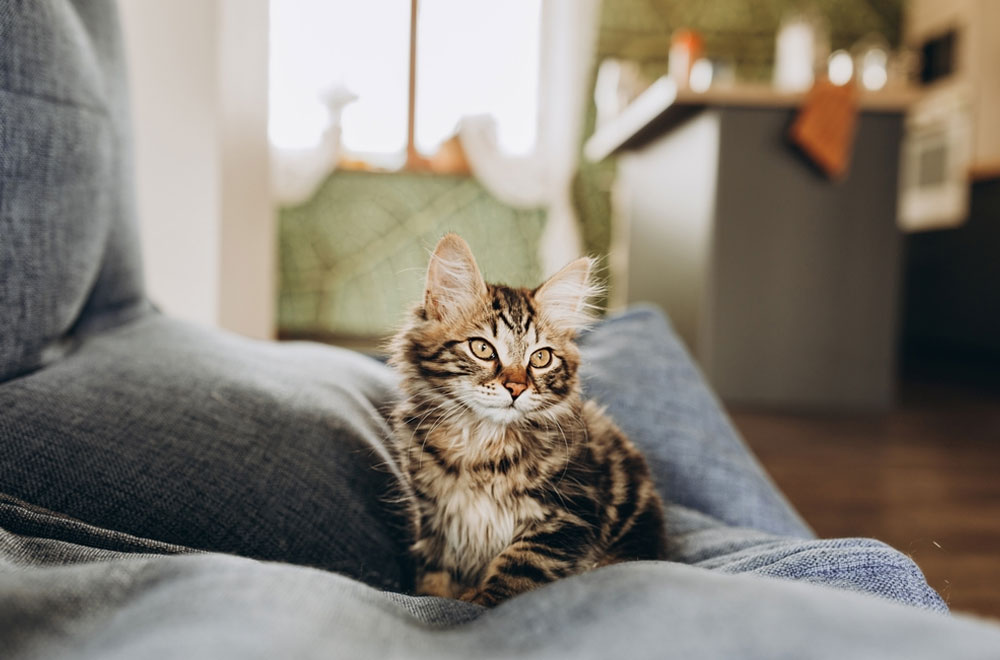Cats may seem to live in the lap of luxury, spending the day sleeping as much as they’d like, enjoying regular meals, and perhaps prowling the neighborhood to keep busy or enjoying the comforts of remaining inside the house. But several health and behavioral issues in cats can be linked to environmental stressors such as other pets, disruptive noises, unfamiliar smells, a change in routine, and more. Sometimes these stressors are not obvious to us; humans and cats do not always find the same things stressful! We hope this article will help you see the world through a cat’s eyes, and help you make your home into a truly stress-free setting for your cats.
1. Privacy
There is something very different about cats, as compared to humans, dogs, and most other animals we share our lives with: In a cat’s evolutionary past, life was spent as a solitary animal, not in a pack or social group. While many cats enjoy the company of other pets in our household, privacy is even more important to cats than it is to us.
Just as some people are introverted and shy while others are chatty and social, some cats have a greater need for access to privacy than others. Your cat may enjoy your company a majority of the time, but at other times a quiet setting is preferred. In a multi-pet household, a cat may have “allies” as well as other individuals they either ignore or may have conflicts with.
Sometimes even the presence of another cat in the same room, or along the path to access a litter box, etc., will inhibit a cat from feeling comfortable with the situation and affect the way they feel and behave. Enabling your cats to live private lives increases the chances they will get along well when they do interact.
Even a cat who lives exclusively indoors may be stressed by outdoor cats or wildlife visible through windows or doors. If your cat appears bothered by the presence of animals outside, block their view in those locations to prevent further distress. Do not encourage strays to approach your home: If you feed outdoor cats, do not place food too close to your home, especially not near doors or windows.
While humans and dogs’ social interactions involve physical contact and body language, cats are quite different. As solitary animals, much of the communication between cats is oriented towards maintaining a comfortable distance from others. Communicating via body posture, facial rubbing (which leaves behind pheromones), and urine marking are all ways for cats to communicate while remaining separated over distance and/or time, so they may avoid contact with strangers or enemies and avoid physical confrontations. A cat who urine-marks is trying to resolve their conflicts peacefully, by leaving a defensive message that will remain after they have left the area (it is we humans who interpret urine marking as a battle!!).
2. Food
Keep the concept of privacy in mind as it pertains to meals. Some cats contentedly eat out of the same bowl as a companion, but in other cases cats may compete for food, or a shy cat may hesitate to eat in the presence of another. Allow each cat to have its own food bowl, out of direct sight of other cats, and consider feeding in separate rooms if there is any tension between them.
Cats who do not seem to get along well from day-to-day should not be fed in close proximity to each other. As solitary hunters, eating is not meant to be a social event for a cat, and eating face-to-face will not turn enemies into friends. Cats who do not get along but will eat together are likely just tolerating each other out of necessity, and these interactions may be a source of further anxiety for them.
3. Water
Just as a cat may feel bullied away from a food source, a timid cat may also hesitate to approach a water bowl if a rival pet or human is nearby. Cats are relatively thirst-tolerant (they can ignore feelings of thirst for prolonged periods of time), but water deprivation can be damaging to the kidneys. Place several water bowls around your home, thereby encouraging your cats to drink more frequently.
4. Places to eliminate
Cats do not share latrines in the wild and they prefer to have separate locations to eliminate urine and feces. As a result, the recommended number of litter boxes in a home is one more than the number of cats (so a home with two cats should have three litter boxes), particularly for indoor-only cats.
Litter boxes should be placed in different areas of the home, not all together in one location. Food/water and litter boxes should be placed in different rooms; in fact, a very common reason for cats urinating or defecating outside of their litter box is the placement of food and litter boxes close together.
The perfect litter box for most cats would be generously sized with a deep layer of litter. An unscented clay-based litter is what most cats prefer, scooped daily. Some cats prefer a covered litter box, while others do not. Never attempt to catch or medicate a cat while they are in their litter box, and do not allow children or other pets to “ambush” a cat using the litter box. Some cats will not tolerate self-cleaning litter boxes; if you plan to introduce one, maintain the option of standard litter boxes in
other locations.
5. Places to rest (including open space & height)
Cats are natural climbers, and aside from climbing being enjoyable, being able to access the top of a tall object gives them a great vantage point in the room. Though cats are predators, they are also physically small, and are therefore also potential prey animals in an evolutionary setting. Even when a cat is truly safe from predators within their own home, they gain a feeling of comfort from being able to access a high-up vantage point.
In the wild, a cat would not use the same resting location consistently; instead they would move from place to place to avoid being re-infested with their own parasites (such as fleas). This is the reason they’re so enamored by the novelty of an empty cardboard box on the floor! Providing a variety of comfortable places for a cat to rest provides the variety they prefer as well as the opportunity to avoid another pet in the household if desired.
6. Opportunities for hunting behavior
A wild cat would engage in hunting behavior for six or more hours per day. When food is provided in a bowl, playful hunting behaviors can take the place of hunting for food. But who says food has to come out of a bowl? There are a variety of treat-dispensing toys (or even simply tossing pieces of kibble across the floor for the cat to chase) to help occupy time that would otherwise have been dedicated to hunting. Check out the “NoBowl” system, “Funkitty Egg-cersizer,” “Funkitty Twist ‘n Treat” made by PetSafe. Crafty cat owners can also make their own inexpensive puzzle feeders at home out of cardboard tubes and disposable plastic containers.
Any game of chasing a toy or laser pointer, pouncing on something from a hiding place, or batting an object around on the floor is mimicking hunting behavior. When you play with your cat, remember the toy’s action should mimic prey – mice don’t run towards cats, they run away! A cat’s attention span for any single toy rarely lasts more than ten minutes, so providing a variety of toys scattered around the house is the best way to draw their attention back to playing and exercising. You can also offer toys on a rotating basis, to keep them all seeming novel and interesting to your cats.
7. Opportunities to claw
Cats claw at objects for a variety of reasons: (1) to stretch back muscles after sleeping, (2) to mark boundaries of territory, (3) to sharpen claws, and (4) for attention. Therefore, the optimal scratching location is (1) close to a preferred resting or sleeping location (2) near doors leading outside of the home, (3) a satisfying texture, and (4) in areas where humans spend time in the home.
Provide your cat with a variety of appropriate scratching surfaces to prevent them from taking advantage of your furniture for this purpose! The ideal scratching post is (1) Tall or wide enough to permit stretching to full body length, (2) of sturdy construction and heavy enough to not rock or tilt when leaned on, (3) includes a variety of surfaces such as carpet or carpet backing, sisal, and soft wood, and (4) is located in a higher-traffic area of the home. Think tree-like! And remember, multiple cats in the home may mean multiple scratching posts are needed.
8. A Comfortable Smell
This probably sounds odd to a human, as our species has a relatively poor sense of smell. To a cat, odors are as important as vision, and cats routinely scent-mark their habitat via facial rubbing and (sometimes) urine marking.
Humans cannot smell cats’ pheromones, so these odors are no bother to us. When you wash your cat’s bedding, use an unscented detergent. Avoid using scented cleaning products or scented room sprays in your home overall.
If a cat urinates or defecates outside their box, the proper way to clean it is to begin with an enzyme-based cleaner (such as Nature’s Miracle). You may then use your disinfectant of choice; an unscented variety is ideal. Allow the cleaned spot to dry fully before allowing the cat to come in contact with it again. Any remaining odor may encourage them to urinate there again.
Particularly for stressed or nervous cats, you may consider the use of a pheromone product. The odor of a synthetic pheromone product cannot be detected by a human, but it can provide cats with a sense of comfort and well-being in their environment, helping them overcome behavior problems.
- Feliway Original is an analog of the scent a cat leaves behind from facial rubbing. Thisscent tells the cat that its environment is safe and secure. It can be especially useful when introducing cats to a new home. Apply the spray or place the diffuser in the room where a stressed cat spends the most time.
- Feliway Multicat is the analog of the scent a kitten experiences when it is nursing from its mother. This scent tells the cat that the individuals around it are safe and secure. It can be useful in multi-cat households, especially where cats have experienced conflicts or social stresses. Apply the spray or place the diffuser in the room where your cats most frequently interact.
- Feliway Optimum combines the Original and Multicat pheromones described above, as well as an additional pheromone to maximize a calming effect in a variety of situations.
Are you seeing your cat’s home environment a little differently now? Planning to build a forest of scratching posts in your living room? Whether the changes you make are drastic or subtle, there is much to be done to keep our feline companions happy and comfortable.
In cases where all of the points above have been addressed to the extent possible, yet behavior concerns persist, prescription medications such as fluoxetine, gabapentin, and amitriptyline may be discussed with your veterinarian as an additional means of management.
References / Further Reading
Books:
The Trainable Cat by Sarah Ellis & John Bradshaw
Cat Sense by John Bradshaw
Decoding Your Cat by the American College of Veterinary Behaviorists
Web resources:
The Indoor Pet Initiative – indoorpet.osu.edu/cats
Cat Behavior Described – learnaboutcats.co.uk
International Cat Care – icatcare.org/cat-advice
Feliway products – https://us.feliway.com/ – generics of some products are also available






Leave A Comment